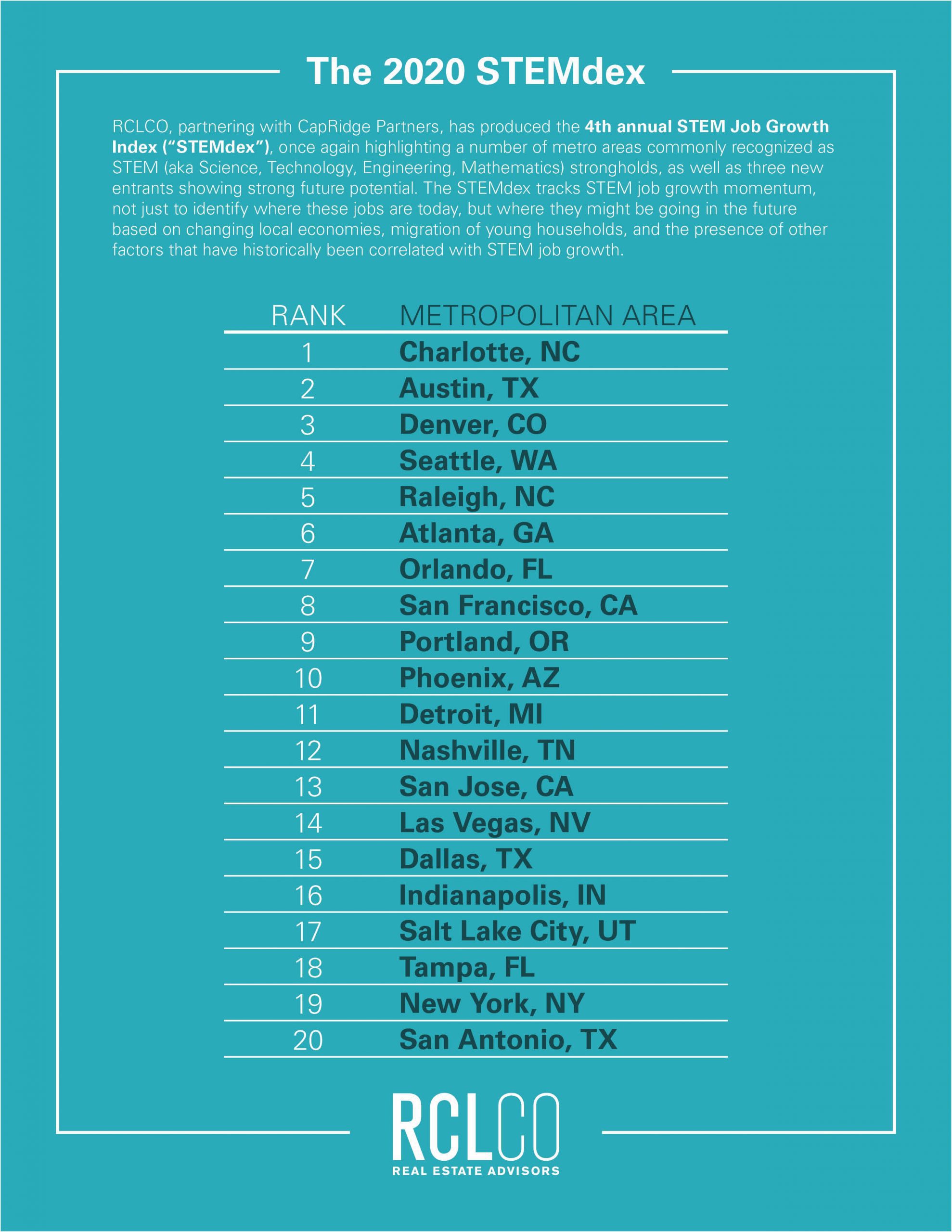
July 21, 2020
RCLCO, partnering with CapRidge Partners, has produced the 4th annual STEM Job Growth Index (“STEMdex”), once again highlighting a number of metro areas commonly recognized as STEM strongholds, as well as three new entrants showing strong future potential. The STEMdex tracks STEM job growth momentum, not just to identify where these jobs are today, but where they might be going in the future based on changing local economies, migration of young households, and the presence of other factors that have historically been correlated with STEM job growth. Understanding this momentum is important to real estate investors, policymakers, and local governments, as STEM jobs will likely play an outsized role in economic growth and prosperity during this century.
The STEM Economy and Growth in a Post-COVID World
The U.S. economy has seen a tremendous increase in the prevalence of STEM employment (STEM is an acronym for Science, Technology, Engineering, and Mathematics) since the turn of the century. Among the 38 metropolitan areas analyzed for the STEMdex, the total STEM employment grew at a combined average annual rate of 7.4%. According to the Bureau of Labor Statistics, STEM occupations are forecast to grow at a rate over 76% higher than non-STEM job growth nationwide. STEM jobs are important for any region’s economy, not only because of their increased prevalence, but also due to their significantly higher wages (STEM employment paid on average $84,880 compared to $37,020 for non-STEM occupations).
STEM employment includes a broad diversity of job types, with over 70% requiring a bachelor’s degree as a minimum level of educational attainment, compared to 21% of the overall job market. The fastest growing STEM jobs are statisticians, research analysts, cartographers, and biomedical engineers, which all require extensive educational achievements to perform. However, there has also been significant growth in STEM jobs that do not necessarily require significant educational attainment, such as web developers, computer support specialists, and petroleum technicians. About 50% of STEM jobs are explicitly computer-related, including computer and information systems management, programmers, software developers, and other computer support specialists. Mathematical, engineering, life and physical science, and social science occupations comprise the other half of STEM jobs.
STEM Occupations
Source: U.S. Census Bureau
Over the past few months, many industries have been affected by the impacts of COVID-19 as the US economy lost over 20 million jobs in April. The hardest hit industries thus far have included leisure and hospitality as well as retail trade jobs, which saw nearly half of those April losses at 10 million combined jobs. However, STEM jobs, with their typically lower rates of unemployment and higher wages, may prove to be more resilient as the country emerges from this health crisis. The rate of job losses throughout this crisis has varied by education level, and those with only a high school degree have been impacted the most significantly. STEM jobs, with over 70% typically requiring a bachelor’s degree, have fared better than others with unemployment rates for those with a Bachelor’s degree being about half of the unemployment rates for those with only a high school education (8.4% as opposed to 17.3%). Many STEM-related jobs, in comparison to those industries which have been hit the hardest by this health crisis, are also better-equipped to transition toward remote working environments. Additionally, some STEM jobs, particularly those related to public health, may even see a renewed sense of importance as we enter a post-COVID economy.
The effects of this pandemic, aside from the economic consequences, have had a significant impact on the way many Americans view public health, and the role that science plays in their lives. Access to healthcare and preventative medicine, health and science literacy, and the delivery of effective therapies and new research will be some of the important challenges that we face as a country in the coming years. STEM jobs will play a key role in solving these challenges, and for that reason must continue to be a key area of focus. Understanding where these jobs exist today, and utilizing the STEMdex to understand where they may concentrate tomorrow, is important to real estate investors, policymakers, and local governments, as STEM jobs will likely play an even more significant role in economic growth and prosperity in a post-COVID world.
The 2020 STEM Job Growth Index (STEMdex)
RCLCO partnered with CapRidge Partners, an office investment management firm, to create the 2020 STEM Job Growth Index (“STEMdex”) as a tool to identify which of the 38 largest metropolitan areas in the United States are primed for growth in STEM-based industries. Our analysis focuses on metrics in four major areas RCLCO/CapRidge find to be paramount to the growth of STEM jobs: Population and Economic Growth, Workforce Quality, Quality of Life, and the Cost of Doing Business. In total, we analyzed 26 different indicators that we believe best characterize the four major categories and would allow us to quantify their impact on the STEM job market. Each indicator was assigned a weighting based on its projected relative importance to the STEM job market; in aggregate, these metrics were combined to create our STEM index rankings for 2020.
The top 20 metropolitan areas in the 2020 edition of the STEMdex are as follows:

What Has Changed?
We continue to refine the index each year based on both changes in data sources and observations in the market. The top five spots have shuffled among themselves, but the markets within these ranks remain unchanged from the 2019 index. Charlotte, NC is now leading the way followed closely by Austin, TX and Denver, CO. A comparison of this year’s top markets compared to the prior two years is shown below, along with an overview of how the results have changed over time.
STEMdex Rankings over Time
SOURCE: RCLCO; CapRidge Partners
New Metropolitan Areas: Indianapolis, Tampa, and San Antonio are the newest entrants into the RCLCO/CapRidge STEMdex which is indicative of their potential to attract future high-tech employment. Indianapolis enjoyed strong relative progress in Quality of Life metrics compared to other cities, while Tampa was a major mover in the Growth categories and Cost of Doing Business. San Antonio moved upwards in Growth and Quality of Life. Both Tampa and San Antonio have enjoyed and are forecast to continue to experience strong population growth, especially among young, highly educated professionals.
Departing Metropolitan Areas: When three new metropolitan areas enter the top 20 of the STEM Job Growth Index, it must be done at the expense of three metropolitan areas leaving the top 20. It is important to note that the STEMdex rewards positive demographic and economic trends in a market much more than it penalizes negative growth. Therefore, when cities leave the rankings it typically says more about the cities who are replacing them than the departing ones, as conditions there still remain stable. With that being said, Houston, Boston, and San Diego (who were previously ranked 13th, 16th, and 20th in the prior index) now sit just outside the top 20.
Cities Likely to Remain in Future Rankings: Given each region’s economic fundamentals and relative attractiveness for young professionals, it is expected that the cities in the top five (Charlotte, Austin, Denver, Seattle, and Raleigh) will all remain at or near the top in future years of study. Other candidates for long-term relevance in the STEMdex include Orlando and Nashville which are both enjoying a significant degree of young professional migration and wage growth with relatively affordable cost of living compared to other cities in the index. Both cities recently opened new Amazon facilities and Orlando is home to Lake Nona’s “Medical City” – a hot bed of medical research and other healthcare-oriented jobs.
2020 STEM Index Rankings Map
SOURCE: RCLCO; CapRidge Partners; Google Maps
Article and research prepared by Karl Pischke, Vice President, and Ryan Guerdan, Associate.
Disclaimer: Reasonable efforts have been made to ensure that the data contained in this Advisory reflect accurate and timely information, and the data is believed to be reliable and comprehensive. The Advisory is based on estimates, assumptions, and other information developed by RCLCO from its independent research effort and general knowledge of the industry. This Advisory contains opinions that represent our view of reasonable expectations at this particular time, but our opinions are not offered as predictions or assurances that particular events will occur.










